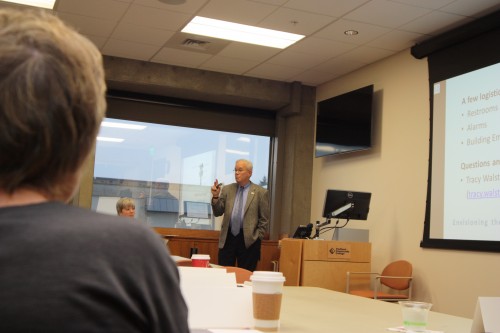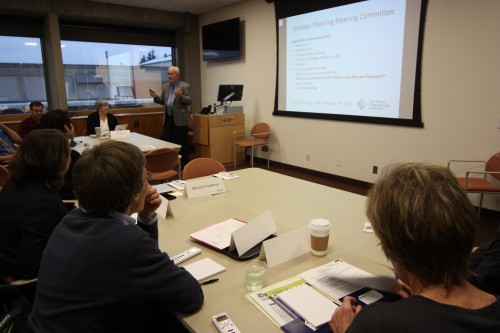This content was published: January 28, 2014. Phone numbers, email addresses, and other information may have changed.
Randy McEwen Q & A: College making strides in strategic planning process
Story by Kate Chester. Photos by James Hill.
Since the start of the current academic year the college has led a strategic planning process. Input generated at the fall In-Service from faculty and staff – about “audacious” goals for the college, as well as words and phrases to describe PCC’s strengths – was followed by the “Campus Conversions” series this fall throughout the district, which touched on the strategic planning process. Additionally, a strategic planning steering committee was named from a pool of more than 70 applicants from throughout the college.
The steering committee – led by Vice President Randy McEwen – has been instrumental in outlining the beginnings of a strategic plan to best serve students and the community at large, now and over the next five years. The overall effort is underscored by the desire to build on PCC’s successes of the past while charting a path for innovation, excellence in education and alignment of budget priorities for the college’s future.
The process will result in the creation of a strategic plan later this year. The plan itself will be a “living” document, according to McEwen, one that is revisited annually and used frequently to guide the college in decision-making and resource allocation and that will yield positive changes with impact.
Following is a question-and-answer with McEwen about his experience leading the steering committee and what strategic planning means for the college. For more information, visit the strategic planning webpage.
Please describe your role in Strategic Planning and the Steering Committee.
McEwen: Dr. Jeremy Brown invited me to chair the Strategic Planning Steering Committee. As such, I am responsible to him for the process by which PCC’s future strategic plan is developed.
Can you outline the overall purpose of Strategic Planning – and why PCC is doing this?
McEwen: The overall purpose is to provide a road map, once approved by the college president and the Board of Directors, by which PCC will achieve its mission, vision, and values going forward. Such a road map establishes a context (“where we’re going together”) for decision-making at critical junctures in the College’s future.
The reasons PCC is doing this are numerous, most of which have to do with the sea of change that we are immersed in: the changing landscape of higher education on a local, regional, national, and global scale; the changes in higher education under way in Oregon; changing student needs, desires, demographics, and expectations; discourse on the expectations for community colleges; and advances in technology and pedagogy.
In addition, the PCC Board of Directors has determined that a strategic plan is essential to the College’s future. And the Northwest Commission, our accrediting agency, requires us to demonstrate that we have a strategic context to guide our decision-making.
Who makes up the Steering Committee?
McEwen: Dr. Brown solicited volunteers for the committee in September, and more than 70 people expressed interest. The challenge then became one of forming the membership to be reflective of the PCC community. All employee groups and campuses are represented, as are students, the Board of Directors, and the PCC Foundation Board.
How many times has the Steering Committee met? When did it first meet? How often does it meet?
McEwen: The Steering Committee has met seven times, starting in mid-November. Currently it meets weekly. The plan is to meet weekly through the end of January or mid-February; then shift to bi-weekly through April, then back to weekly in May to prepare a draft of the plan for Dr. Brown’s review.
What does the group cover in each meeting?
McEwen: The agenda varies from meeting to meeting, along a progressive path. The first two meetings were devoted to the committee sharing thoughts and discussion on the question: “What is your vision of PCC’s impact in five years?” The third meeting, and part of the fourth, were devoted to grounding in essential background data about PCC. Subsequent meetings have discussed PCC’s strengths, weaknesses, threats, and opportunities.
In upcoming meetings, our challenge will be to tease out the “essential few” strategic themes or thrusts on which further work will be done through April.
Why should a faculty member or a student care about Strategic Planning? What’s “in it” for them?
McEwen: We all care about PCC, and its vision and mission. We all, in one way or another, are devoted to the cause of serving students and of ensuring that the PCC enterprise is sustainable and successful in the future. We also are a community of ideas about how to serve students and what is important in the future.
The strategic plan is intended to provide a context or roadmap. What’s “in it” for each of us is the opportunity to see ourselves in that context, regardless of the specific work that we do daily. It’s in understanding “where we are headed” and having a chance to contribute to that.
Will you be eliciting feedback from the college to share with the committee? If so, how will you obtain this feedback?
McEwen: Yes. We are starting up the capability in Spaces to provide input to the same kinds of questions that the Steering Committee is discussing. That input will be seen by the committee and the College. We are also setting up a “Strategic Planning update” area on PCC.edu.
Personal Biography – Randy McEwen:
- Date Joined PCC: January 1999 as director of the Physical Plant.
- Hometown: Payette, Idaho (a small farm town in western Idaho). He took classes during Treasure Valley Community College’s first-ever term, “way back when.”
- College and Degrees: Stanford University. He received BS and MS degrees in Electrical Engineering/Computer Science.
- Professional Expertise: Driving and repairing U.S. Navy ships; pulp and paper manufacturing operations and technology; in general, operations leadership and management.




As a long-time PCC employee, I have no faith at all that any staff contributions to this effort will have any impact at all. When you try to have a say, you are ignored. Three or four people at PCC make all of the decisions – the rest of us just get to live in their world. :-(
@ Fred, ……and how is that different from anywhere else?
For my first AAS degree in printing technology from Fullerton Junior-College in 1978. Math requirements included basic math and then “related math” which was focused on the trade-skills by major. The relevancy of this made successful completion likely for AAS seekers. Also as a vision thought.. I believe a class in personal finance was required as well, with more real-life problem solving. Relevant issues to the students not transferring to a 4-year school.
@NotFred: Why make a big show of saying how much you value everyone’s comments when you have no intention of doing anything with them? Public involvement at PCC is really “involvement theater” and a waste of everyone’s time. I do agree that much of what passes for public process in Portland is like this – a lot of show with very little ROI for anyone who takes the time to participate.
The link to the comment section for the strategic plan doesn’t work. I can’t log in because I’m not an administrator. If anyone ever reads this, I think that childcare assistance for disabled students, especially ones who take classes online, should be a priority.